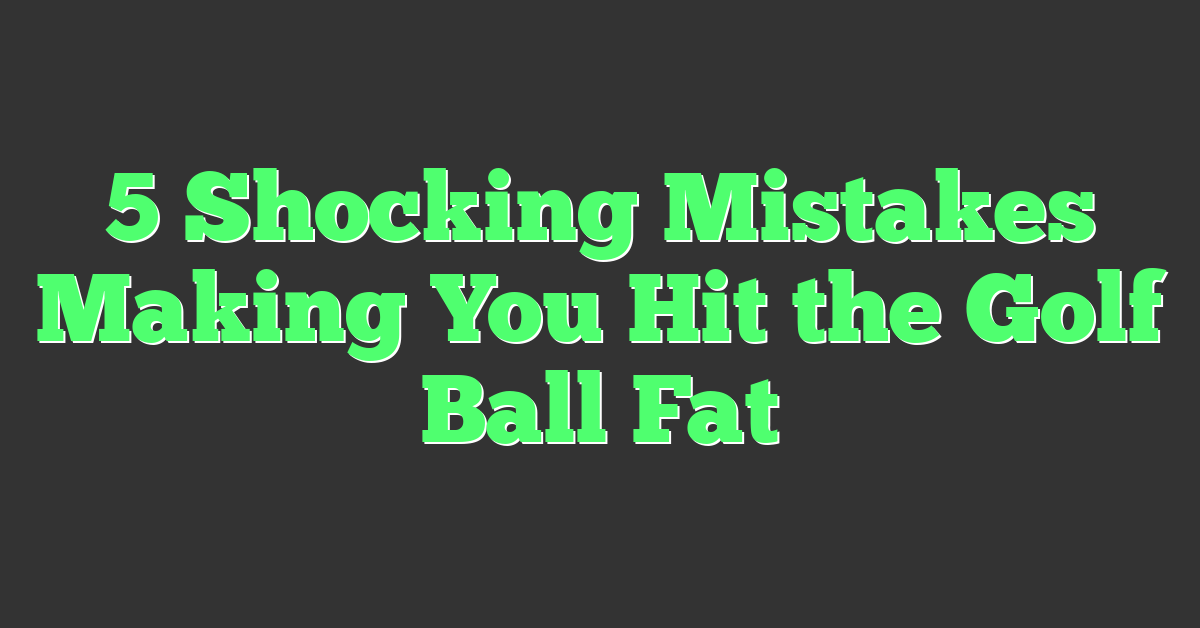Ever wondered why your golf ball veers off like a mischievous pet when you’re aiming for a straight shot? It’s all about the spin. But fear not, because there’s a ball out there that’ll keep you on the straight and narrow.

You’re in luck because today’s market offers a variety of golf balls designed to minimize spin and maximize your control. Whether you’re battling a slice or just looking for a more predictable game, finding the right low-spin golf ball can be a game-changer.
The Role of Spin in Golf
As a seasoned golfer, you’re always seeking ways to refine your game and lower your scores. Understanding the role of spin is crucial to this pursuit. Remember, in golf, spin isn’t just about making the ball curve in the air; it’s about control and precision.
When you strike the ball, spin dictates its behavior during flight and upon landing. High spin can lead to a dramatic shot shape and stop the ball quickly on greens. Low spin, conversely, decreases air resistance, enabling longer drives and more roll out on the fairway.
Awareness of spin becomes especially important in adverse conditions. Wind can wreak havoc on a high-spinning ball, but a low-spin ball cuts through the air, maintaining a steadier course. That’s why choosing the right ball matters; it’s not just about what feels good off the clubface, it’s about how it performs in the elements.
The type of shot you’re playing also influences the desired spin. For tee shots, you’re looking for reduced backspin to maximize distance. Yet, around the greens, spin becomes your ally as you aim for those close-up pitches to stick by the hole. Knowing this balance is the hallmark of a savvy player.
Let’s get down to the nitty-gritty:
- Driver Spin: Aim for lower spin to enhance distance and reduce side spin which causes hooks or slices.
- Iron Spin: Moderate spin allows for shot shaping and stopping power on the green.
- Wedge Spin: Higher spin provides the control you need for precision short game shots.
Keep in mind, the club, swing speed, and attack angle all play a role in generating spin, but the golf ball you choose can tip the scales in your favor. Whether you’re battling a hook or hunting for more distance, understanding spin will help you select the best ball for the job. Keep experimenting to find that perfect match for your game.
Understanding the Different Types of Spin in Golf
When you’re delving into the complexities of spin in golf, it’s essential to understand that there are various types of spin that can affect the ball’s movement and your overall performance. Primarily, there’s backspin and sidespin, both playing unique roles in the game.
Backspin, like the name suggests, is the backward rotation of the golf ball as it flies through the air. It’s what makes the ball rise and, more importantly, stop quickly or even back up after hitting the green. As you’ve probably noticed, shots that lack backspin tend to roll out further, which isn’t ideal when you’re aiming for precision.
On the flip side, sidespin occurs when the ball spins on a horizontal axis. This is what causes those frustrating hooks and slices, pulling your ball left or right of where you want it to go. It’s often an indicator of a mishit, albeit an excellent tool for shaping shots once you have a handle on controlling it.
Achieving the desired spin comes down to several factors:
- Club selection: Different clubs are designed to impart different spin rates. For instance, your wedge will generate more backspin compared to your driver.
- Ball design: The construction of the ball plays a massive role. Multi-layered balls with a softer cover tend to increase backspin.
- Contact quality: How you strike the ball greatly influences spin. A clean, crisp contact with the right club will promote better backspin.
For golfers aiming to reduce their spin rates, it’s pivotal to choose a golf ball that’s engineered to minimize spin, especially off the tee. Balls with a harder cover and fewer layers usually result in lower spin rates, allowing for straighter flights and more run on the fairway.
It’s also worth considering your swing mechanics. A smoother, slower swing will reduce the spin you impart on the ball versus a fast, aggressive swing. Think about how your grip, stance, and swing path are contributing to the spin, and work with a golf instructor if you’re struggling to make the necessary adjustments.
Factors to Consider When Choosing a Golf Ball with Low Spin
When you’re on the hunt for a golf ball that’ll give you less spin, you’ve got to know what to look for. Not all golf balls are created equal, and there’s a bit more than just the label on the box to consider.
First up, ball construction plays a big role. Typically, balls designed for less spin have a two-piece construction with a durable, cut-resistant cover. These often have a solid core designed to launch straight and true. In contrast, more advanced balls with multi-layer designs are tailored for players who want more spin, so these might not be what you need.
Next, think about compression. Low compression balls are softer and can reduce spin, making them a good choice if your swing speed isn’t breaking any records. They’ll help you get that distance without overdoing the spin.
Remember, though, it’s not just about the guts of the ball. The cover material matters too. Surlyn covers are generally associated with low spin balls, while urethane covers are often on high spin models. Surlyn is your friend if you’re chasing that straight, low spin flight.
- Two-piece construction with Surlyn cover
- Low compression for slower swing speeds
- Durable and designed for distance
Also, you can’t ignore the importance of the dimple pattern. It’s all about aerodynamics: the right dimple pattern can stabilize the ball’s flight and reduce spin. Manufacturers are pretty cagey about how these patterns are engineered, but it’s something to keep an eye on.
Lastly, ponder over the feel of the ball. It’s usually a personal preference, but a ball with less spin might feel different on the green. Make sure what you gain on the drive, you don’t lose on the short game.

- Aerodynamic dimple patterns for stable flight
- Consider the feel on the green
Think about what works best with your playing style and don’t be afraid to experiment a little. Your perfect low spin golf ball is out there waiting for you.
Top Golf Balls for Low Spin Performance
As someone who’s navigated the fairways for a lifetime, you’ve likely experienced moments when less spin made a world of difference. Chasing that scorecard perfection, low spin golf balls can be the ace in your pocket. They’re engineered to cut through the air and roll out further, getting you closer to the pin, without the unwanted dance away from your target.
Diving into specifics, let’s talk about some leading options in the market. The Titleist AVX is a standout choice. It’s designed for golfers like you who prioritize distance with a controlled flight. Another top performer is the Callaway Chrome Soft X, which boasts a Dual SoftFast core that promotes low spin for your long game without compromising on feel around the greens.
The Choices That Make the Cut
- Titleist AVX: With a soft feel and high speed, it’s tailored for those desiring a piercing, low spin flight.
- Callaway Chrome Soft X: A fine-tuned construction that helps you achieve both distance and control.
- Srixon Z-Star XV: Known for its ‘FastLayer’ core, giving you the dual benefit of low spin off the driver and exceptional control with irons.
Remember, each golfer’s swing is unique. The Srixon Z-Star XV might suit golfers with a faster swing speed, harnessing that energy for optimal performance. It’s not just about lower spin; it’s about finding the right balance that works for your game.
Exploring further, the likes of Bridgestone Tour B XS and the TaylorMade TP5x have also garnered attention for their low spin qualities. The Tour B XS is engineered with a ‘REACTIV’ cover that adjusts to your shot, providing reduced spin for longer shots and increasing spin where it counts. Meanwhile, the TP5x brings a 5-layer construction to the table, giving you the control over spin that’s paramount for serious golfers.

Finding Your Match
Dimple patterns, core construction, and even cover stiffness play pivotal roles in spin behavior. It’s crucial you consider your swing characteristics and what you want to achieve on the course. Don’t hesitate to test out different balls during practice rounds. After all, firsthand experience is the best way to gauge performance.
Testing and Comparing Low Spin Golf Balls
When looking to perfect your golf game, testing different golf balls is as crucial as perfecting your swing. Begin by collecting a variety of low spin golf balls mentioned earlier, like the Titleist AVX, Callaway Chrome Soft X, and the others. It’s key to test them in various conditions and shots for a thorough comparison.
Initiate your test with driver shots, since reducing spin off the tee can be beneficial for distance and control. You’ll want to note not just the distance each ball travels but how it feels at impact and its trajectory. A launch monitor can give you precise spin rates, but you’ll also get a good indication just by observing the flight pattern and roll-out after landing.
Iron shots are next. With these, you’re looking for a balance between low spin and enough stoppage power on the green. Strike some full swings with your mid-irons and pay attention to how the ball reacts on approach. Is it holding the green or rolling out too much?
Don’t forget the short game. Despite looking for overall lower spin, knowing how each ball performs with your wedges is essential for those key up-and-downs. Execute a series of chip and pitch shots, and observe the ball’s responsiveness. Ideally, you’re aiming for a ball that offers control without excessive spin that can sometimes lead to unpredictability around the greens.

For a more structured approach, create a simple testing matrix:
| Ball Type | Driver Spin Rate | Iron Stoppage | Wedge Control |
|---|---|---|---|
| Titleist AVX | x rpm | y seconds | High |
| Chrome Soft X | x rpm | y seconds | Medium |
| Srixon Z-Star | x rpm | y seconds | Low |
| …etc |
Replace the x’s and y’s with your observations. By consulting this table, you’ll visually discern which balls might suit your game best.
Conclusion
You’ve seen how the right golf ball can significantly impact your game, especially when it comes to spin. With options like the Titleist AVX and TaylorMade TP5x, you’re now equipped with the knowledge to make an informed choice. Don’t forget to test these balls under various conditions to see which one meshes with your swing and helps you nail those shots. It’s all about finding that perfect match for your game. So grab a sleeve of low spin balls and get ready to see the difference on the course. Happy golfing!










